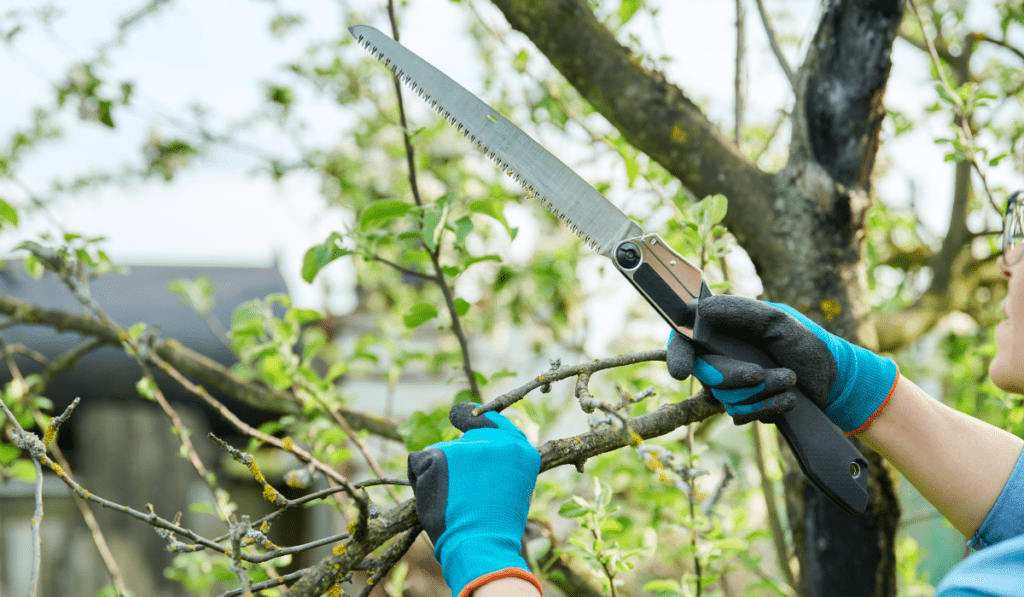Pruning saws are used for making three main types of cuts on apple trees: heading cuts, thinning cuts, and notch cuts. These cuts help shape the tree, control its size, promote airflow, remove dead or damaged wood, and improve the overall health and yield of the tree.
Pruning saws are versatile tools that can handle both delicate and heavy-duty cuts, making them suitable for various pruning tasks on apple trees. To successfully prune an apple tree, it’s important to understand the purpose and technique behind each type of cut.
We will explore these different types of cuts in detail and provide guidance on when and how to make them to maintain a thriving apple tree.
Types Of Cuts With Pruning Saws
Pruning saws for apple trees have different types of cuts, including the thinning cut to remove excess branches, the heading cut to encourage new growth, and the reduction cut to control tree size. These cuts help maintain the tree’s shape and promote healthy fruit production.
Pruning is an essential task when it comes to maintaining the health and appearance of apple trees. And when it comes to pruning, using the right tools is crucial. Among the various tools available for pruning, a pruning saw is an excellent choice for cutting through larger branches and thicker wood. Pruning saws are designed to make clean and precise cuts, helping to promote healthy growth and improve the overall structure of the tree. In this section, we will explore the different types of cuts that can be made with pruning saws when pruning apple trees.
Heading 1: Pruning Cuts
Pruning cuts with a pruning saw are generally divided into three main types: heading cuts, thinning cuts, and removal cuts. Each type of cut serves a specific purpose and should be performed with care to ensure the best results for the apple tree.
Heading 2: Heading Cuts
Heading cuts, also known as reduction cuts, involve removing a portion of a branch to control its length and redirect growth. This type of cut is typically made just above a bud or lateral branch, stimulating new growth and encouraging the development of a well-balanced branch structure. Heading cuts are commonly used to shape the canopy, control the height of the tree, and remove any dead or damaged wood.
Heading 2: Thinning Cuts
Thinning cuts involve the removal of an entire branch or stem from the point of origin. This type of cut is useful for improving light penetration, airflow, and reducing congestion within the canopy. Thinning cuts help redirect energy to more productive branches, improving overall fruit quality and reducing the risk of disease by allowing better air circulation.
When making thinning cuts, it’s important to remove the branch just outside the branch collar, which is the slightly raised area where the branch attaches to the trunk or another branch. By making cuts in this manner, the tree can heal more effectively.
Heading 2: Removal Cuts
Removal cuts, as the name suggests, involve removing an entire branch or stem from its point of origin. This type of cut is typically used to eliminate problematic branches, such as those that are dead, diseased, or damaged. Removal cuts can also be made to reduce overcrowding and improve the overall health and appearance of the apple tree. When making removal cuts, it’s important to make a clean cut just outside the branch collar to minimize any potential damage to the tree.
In conclusion, different types of cuts can be made with pruning saws when pruning apple trees. Heading cuts are used to control the length and growth of branches, thinning cuts improve light penetration and airflow, while removal cuts eliminate problematic branches. By understanding these types of cuts and using a pruning saw correctly, you can ensure the best results for your apple tree’s health and appearance.
Frequently Asked Questions Of Types Of Cuts With Pruning Saws Apple Tree
What Branches To Cut When Pruning Apple Trees?
When pruning apple trees, it’s crucial to cut dead, diseased, damaged, crossing, or overcrowded branches.
What Are The Different Types Of Pruning Cuts For Fruit Trees?
The different types of pruning cuts for fruit trees include heading cuts, thinning cuts, and renewal cuts. These cuts help manage the tree’s size, shape, and fruit production by removing dead, damaged, or overcrowded branches. Regular pruning is essential for tree health and optimal fruit production.
What Branches To Cut When Pruning?
When pruning, you should cut dead, damaged, or diseased branches. Remove any branches that are crossing or rubbing against each other. Also, trim any branches that are interfering with structures or obstructing visibility.
What Are 3 Most Common Types Of Pruning?
The three most common types of pruning are: shaping (to control the size and form of the plant), maintenance (to remove dead or diseased branches), and rejuvenation (to encourage new growth and improve the health of the plant). Pruning helps promote healthy growth and enhances the overall appearance of plants.
Conclusion
Understanding the different types of cuts with pruning saws for apple trees is crucial for maintaining their health and promoting proper growth. By familiarizing ourselves with these techniques, such as the thinning cut, heading cut, and rejuvenation cut, we can effectively manage our apple trees and ensure their vitality.
Remember to always use sharp and clean pruning tools, and consult professional advice if needed. Happy pruning!



